Version française abrégée
1 Introduction
Sur environ 1300 km du nord-ouest au sud-est, la zone de Sanandaj–Sirjan (ZSS) est un trait structural majeur de l'Iran méridional (Fig. 1A). Elle sépare, au nord-est, le bloc stable de l'Iran central, d'origine gondwanienne [20] de la zone du Zagros, qui constitue au sud-ouest la marge nord-arabe.
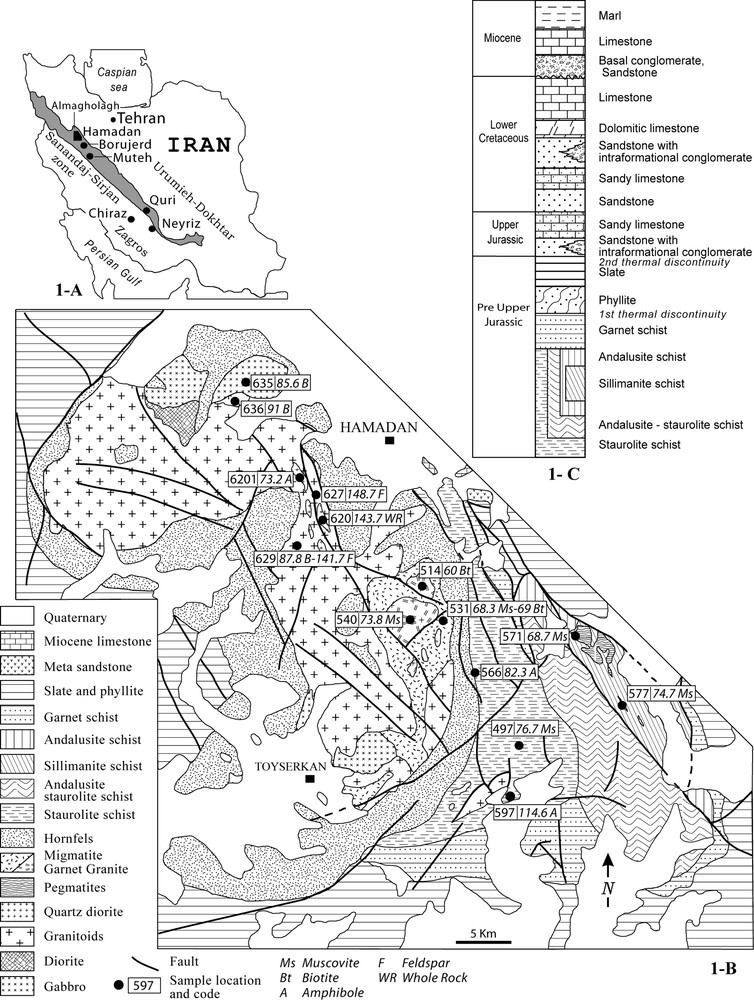
(A) The Sanandaj–Sirjan zone in Iran with location of study area. (B) Geologic map of the area, with dated samples locations and reporting of the measured KAr ages. (C) Stratigraphic column of the area. Note that the represented ages are those of protholiths and not of metamorphism.
(A) La zone de Sanandaj–Sirjan en Iran : la région étudiée est localisée. (B) Carte géologique de la région étudiée et localisation des échantillons datés avec indication des âges KAr mesurés. (C) Colonne lithostratigraphique de la région étudiée. N.B. Les âges indiqués sont ceux des protolites et non ceux du métamorphisme.
Dans la partie nord-ouest de cette zone, la région de Hamadan (Fig. 1B) a été assimilée à l'ancienne marge néo-téthysienne [1], comme les autres parties de la ZSS. Elle a été régulièrement l'objet d'études [2,3,5,7–10,13,18,21]. On y trouve des schistes et des phyllades disposés à l'extérieur d'une structure elliptique NW–SE, d'une cinquantaine de kilomètres de grand axe, avec au cœur des roches à grenat, staurotide et sillimanite et un complexe intrusif, le « granite d'Alvand », dont les paragenèses de contact se superposent aux minéraux syncinématiques. La caractérisation et la datation du métamorphisme, ses liens avec les déformations régionales et avec le magmatisme constituent les questions abordées dans la présente note.
2 La colonne stratigraphique
La déformation ductile, parfois intense, et la fracturation rendent toujours délicate l'interprétation de la nature des contacts entre les unités structurales de la région. Cependant, l'étude de zones-clés et la découverte de quelques rares fossiles ont permis de dresser une colonne lithostratigraphique synthétique (Fig. 1C).
Les roches les plus anciennes, d'âge pré-Jurassique, sont des roches à métamorphisme intense (micaschistes à grenats, staurotide, andalousite et sillimanite) qui ont été rapportées à des périodes très variables selon les auteurs : Furon [6] a proposé un âge Précambrien. La carte de Hamadan au
Vers le haut de la colonne, les roches, des phyllades et schistes ardoisiers, sont moins métamorphiques. Les ardoises ont livré Arietites bisulcatus [18], Posodina alpina [5], Himmatoceras sp. et Pseudomatoceras sp. ? (carte au
3 Métamorphisme et déformation
Trois éléments structuraux planaires successifs, S1, S2 et S3 ont été individualisés à l'échelle du terrain et à celle de la lame mince (Fig. 2A). Dans les roches les plus métamorphiques, les deux premiers correspondent à une foliation synmétamorphique et le troisième à une schistosité de crénulation. Dans les schistes, cependant, une seule schistosité synmétamorphique et une crénulation tardive sont visibles. Globalement, si l'on exclut, bien sûr, les paragenèses développées ultérieurement lors du métamorphisme de contact, le métamorphisme est contemporain de la déformation. De plus, l'absence d'une paragenèse spécifique pour chaque déformation montre que l'évolution métamorphique et structurale s'est probablement développée de façon continue au cours du temps, sans qu'il soit possible de discerner des « phases » thermiques ou des déformations nettement séparées dans le temps.
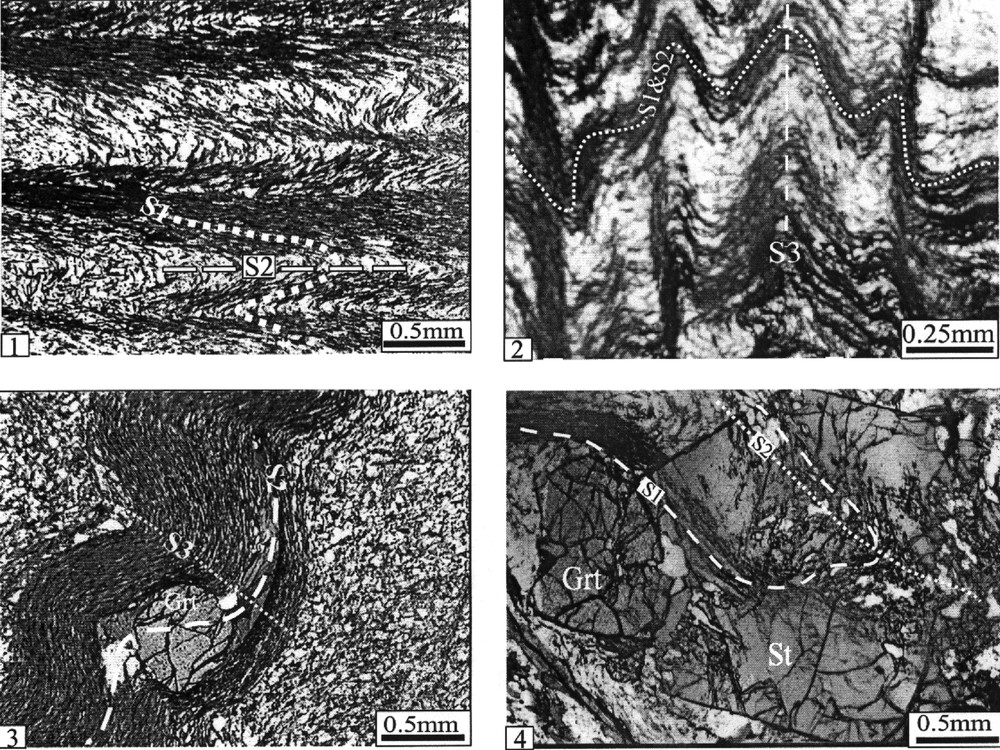
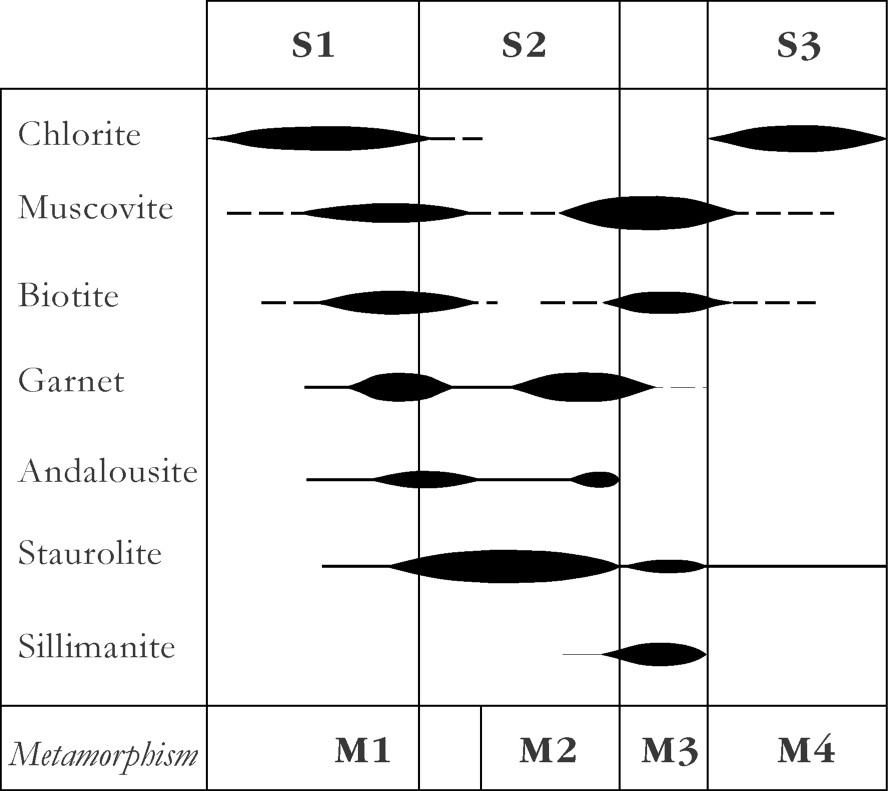
(A) Photographs showing the main microstructural elements in some metamorphic rocks from the Hamadan area: (1) S1 microfolded by tight P2 microfolds, (2) S3 crenulation cleavage, (3) pre-S2 garnet with asymmetrical pressure shadows (the S2 foliation is slightly affected by a S3 crenulation), (4) syn-S2 staurolite with continuous Si (internal schistosity) and Se (external schistosity), showing that no important shear occurred within the foliation plane. (B) Crystallization of the minerals with respect to the tectono-metamorphic events.
Photographies présentant les principaux éléments microstructuraux des roches métamorphiques constitutives des complexes de Hamadan : (1) microplissement de S1 par des plis P2 isoclinaux, (2) schistosité de crénulation S3, (3) grenat Pré-S2 avec queues de cristallisation asymétriques (S2 est légèrement ondulée par une crénulation S3), (4) staurotide syn-S2 avec Si (schistosité interne) et Se (schistosité externe) continues, montrant qu'il n'y a pas de mouvement de cisaillement important dans la foliation. (B) Cristallisation des minéraux du métamorphisme en fonction des épisodes structuraux et métamorphiques. Masquer
Photographies présentant les principaux éléments microstructuraux des roches métamorphiques constitutives des complexes de Hamadan : (1) microplissement de S1 par des plis P2 isoclinaux, (2) schistosité de crénulation S3, (3) grenat Pré-S2 avec queues de cristallisation asymétriques (S2 est légèrement ... Lire la suite
Du point de vue régional, on note que les formations de schistes et de phyllades, affectées par une évolution dynamo-métamorphique peu intense, sont disposées à l'extérieur d'une structure cartographique elliptique (Fig. 1B), d'une cinquantaine de kilomètres de grand axe, orientée NW–SE. Les enveloppes internes sont, quant à elles, constituées de roches affectées par un métamorphisme plus intense à grenat, staurotide et sillimanite. Le cœur de la structure est occupé par un complexe magmatique, le granite d'Alvand, dont les paragenèses de contact se superposent aux minéraux syncinématiques. Des observations de terrain préliminaires montrent que la foliation est engagée dans une forme en dôme, centrée sur le cœur de la structure métamorphique.
4 Datation des événements
La datation de ces évènements a été abordée à partir de la mesure d'âges par la méthode 40K–40Ar de minéraux séparés à partir de 14 échantillons prélevés dans les divers membres de ce complexe, qui perce les formations sédimentaires datées du Jurassique, c'est-à-dire dans les gabbros situés sur la bordure septentrionale de la masse des granitoïdes, dans les filons de diorite quartzique recoupant ces granitoïdes et dans ces granitoïdes, dans les granites à grenat et les migmatites spatialement associés, dans les schistes à staurotide situés sur la bordure orientale du complexe, enfin dans la masse de pegmatite développée dans les schistes à sillimanite.
Les résultats sont présentés dans le Tableau 1 et sur la Fig. 3 et appellent les commentaires qui suivent. Les résultats obtenus sur amphiboles, muscovites et biotites séparées, qui sont les chronomètres KAr les plus fiables, sont interprétés en tant qu'âges de fermeture isotopique [22] de ces minéraux. Ils se répartissent entre 114 Ma, pour les plus anciennes amphiboles d'amphibolites (B597, Tableau 1) dans les schistes à staurotide et 60 Ma pour les biotites des granites à grenat (B514, Tableau 1). Ces résultats, isolés du groupe, mériteront d'être réexaminés ultérieurement.
40K–40Ar isotopic datings for minerals and whole-rocks of selected metamorphic and plutonic rocks from the Hamadan area
Résultats des datations 40K–40Ar sur minéraux séparés et sur roches totales de faciès métamorphiques et plutoniques collectés dans la région de Hamadan
| Sample | Dated fraction | Locality | Type/nature | Anal. ref. | Age (Ma) | ± | error (Ma) | K2O (wt%) | 40Ar* (%) | 40Ar* g−1 |
| B571 | Ms | Tikmeh Dash | Deformed pegmatite | 6070-5 | 68.7 | ± | 1.6 | 9.94 | 75.2 | 224.4 |
| Feld | 6106-7 | 188.8 | ± | 5.6 | 0.24 | 69.4 | 15.4 | |||
| B577 | Ms | Zaman Abad | Pegmatite dike | 6077-4 | 74.7 | ± | 1.8 | 9.94 | 65.2 | 245.8 |
| Feld | 6087-5 | 136.2 | ± | 4 | 0.49 | 65.3 | 22.34 | |||
| B 497 | Ms | Oshagh | Andalusite and kyanite vein | 6101-2 | 76.7 | ± | 1.9 | 8.17 | 61 | 206.4 |
| B627 | Feld | Ganj-Nameh | Pegmatite dike | 6088-6 | 148.7 | ± | 3.4 | 3.99 | 96.1 | 199.9 |
| B514 | Bt | Abaru | Garnet granite body | 6085-3 | 59.4 | ± | 1.5 | 8.89 | 59.4 | 180 |
| 6067-2 | 60.5 | ± | 1.5 | 58.5 | 173.1 | |||||
| Feld | 6105-6 | 86.3 | ± | 2 | 3.5 | 94.3 | 99.76 | |||
| B531 | Bt | Simin | Granite dike in migmatite | 6057-1 | 67.4 | ± | 1.7 | 8.93 | 54.2 | 197.7 |
| 6078-5 | 70.7 | ± | 1.7 | 77.9 | 207.5 | |||||
| Ms | 6084-2 | 68.3 | ± | 1.7 | 10.4 | 62.4 | 233.2 | |||
| Feld | 6110-2 | 89.9 | ± | 2.1 | 6.11 | 90.5 | 181.5 | |||
| B540 | Ms | Simin | Garnet granite body | 6068-3 | 73.8 | ± | 1.8 | 9.85 | 69.9 | 243.6 |
| Feld | 6069-4 | 389.8 | ± | 21 | 0.15 | 71.9 | 21.04 | |||
| B6201 | Amph | Ganj-Nameh | Quartz diorite dike | 6107-8 | 73.2 | ± | 3.1 | 0.12 | 35.1 | 2.89 |
| B620 | WR | Road of Shahrestaneh | Quartz diorite dike | 6080-7 | 143.7 | ± | 5.3 | 0.25 | 65.2 | 12.06 |
| B629 | Bt | Abbas Abad | Porphyroid granite | 6071-6 | 81.8 | ± | 1.9 | 8.92 | 79.3 | 240.7 |
| Qz + Feld | 6072-7 | 147.1 | ± | 3.4 | 2.85 | 96.5 | 140.8 | |||
| B636 | Bt | Cheshmeh Ghassaban | Large diorite enclave | 6102-3 | 91 | ± | 2.2 | 6.42 | 67.5 | 193.3 |
| WR | 6081-8 | 135.2 | ± | 3.1 | 1.08 | 87.4 | 48.89 | |||
| WR–Bt | 6082-9 | 255.3 | ± | 9.4 | 0.22 | 76.2 | 19.45 | |||
| B635 | Bt | Cheshmeh Ghassaban | Large gabbro enclave | 6086-4 | 85.6 | ± | 2 | 9.1 | 80.3 | 257.3 |
| WR–Bt | 6111-3 | 296.9 | ± | 6.8 | 0.99 | 91 | 103 | |||
| B566 | Feld | Arzanfood | Amphibolite in staurolite schist | 6103-4 | 51.4 | ± | 1.6 | 0.57 | 53.7 | 9.58 |
| Amph | 6079-6 | 82.3 | ± | 2.4 | 1.01 | 80.6 | 27.43 | |||
| B597 | Feld | Aliabad Damagh | Amphibolite in staurolite schist | 6104-5 | 40.2 | ± | 1.4 | 0.31 | 35.2 | 4.06 |
| Amph | 6073-8 | 114.6 | ± | 4.3 | 0.31 | 64.3 | 11.82 |
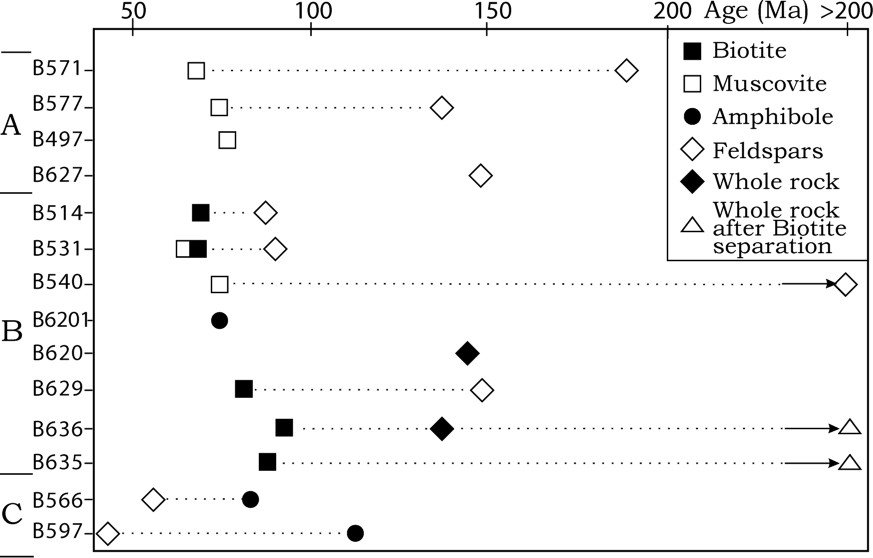
Distribution of isotopic ages against the analysed rock types. (A) Pegmatites and veins; (B) magmatic rocks; (C) staurolite schists.
Distribution des valeurs d'âges isotopiques en fonction des types de roches analysées. (A) Pegmatites et veines ; (B) magmatisme ; (C) schistes à staurotide.
Les biotites des gabbros, diorites et granites donnent des âges compris entre 91 et 82 Ma, qui peuvent indiquer une phase de granitisation majeure, précédée par des corps basiques.
Les muscovites des veines granitiques présentes dans les migmatites et des masses de pegmatite donnent des âges plus récents, compris entre 78 et 68 Ma, indiquant une probable activité filonienne.
Les relations chronologiques entre magmatisme et métamorphisme ne sont pas encore précisément établies, mais on pressent la quasi-contemporanéité de la phase de granitisation et du métamorphisme de haute température.
Les résultats obtenus sur les fractions feldspathiques, calco-sodiques ou sodi-potassiques, sont en discordance avec ceux fournis par les amphiboles ou micas provenant des mêmes échantillons : des âges plus récents (40 à 50 Ma) sont obtenus sur les feldspaths des amphibolites dans les schistes ; des âges un peu plus anciens (86 à 89 Ma) sont obtenus sur les feldspaths des granites associés aux migmatites. Les résultats divers et plus anciens de 135 à 148 Ma, de 200 Ma et 400 Ma de feldspaths de granites et pegmatites (Fig. 3) restent d'interprétation délicate sans données complémentaires, en particulier celles que pourraient fournir des spectres 40Ar–39Ar tracés par paliers de température. Ces résultats, qui sont liés à la présence vraisemblable d'excès d'argon apparus au cours des phénomènes de fusion qui ont localement affecté les unités, ne peuvent être géologiquement qualifiés.
5 Discussion et conclusions
La colonne stratigraphique montre une apparente continuité dans un ensemble mésozoïque (et paléozoïque dans ses parties les plus profondes ?), recouvert en discordance par des niveaux miocènes.
Le métamorphisme syncinématique décroît (Fig. 1C) à l'intérieur de la colonne et, à l'échelle d'investigation, on peut tout au plus admettre deux discontinuités thermiques, ou penser à des variations localement très rapides du gradient métamorphique. On passe ainsi des micaschistes à grenat, staurotide et sillimanite de la base de la colonne aux schistes et phyllades jurassiques du centre et aux roches non ou très peu métamorphiques du Crétacé inférieur, au sommet. Parallèlement, les structures syncinématiques deviennent de moins en moins pénétratives depuis le centre métamorphique de la structure vers ses bordures sédimentaires.
La localisation des roches les plus métamorphiques et des roches plutoniques au centre de cette structure et la forme en dôme dessinée par la foliation et la schistosité synmétamorphiques suggèrent qu'il s'agisse d'un dôme gneissique. La séquence d'événements majeurs se situe au cours du Crétacé supérieur. Les arguments structuraux actuellement disponibles sont cependant insuffisants pour affirmer le caractère extensif de la déformation. L'hypothèse d'un dôme gneissique dans cette région est a priori confortée par la démonstration faite de leur développement ailleurs dans la ZSS [17], à la suite de la déformation éo-cimmérienne.
À la différence des autres secteurs récemment étudiés dans la zone de Sanandaj–Sirjan, on ne retrouve ici, ni la trace d'un épisode de rifting paléozoïque ni, surtout, les premières paragenèses de moyenne à haute pression, peut-être totalement effacées par le flux thermique lié à la mise en place du complexe granitique d'Alvand. Ici, l'événement majeur tectonique, métamorphique de haute température et magmatique, est daté aux alentours de 82 Ma.
1 Introduction
The Sanandaj–Sirjan zone (SSZ), that extends over 1300 km, is a major structural NW–SE trend in southwestern Iran. It separates the stable Central Iran block, which originates from Gondwana, from the Arabian microcontinent [20].
The Hamadan area [2,3,5,7–10,13,18,21], a part of the SSZ [20] (Fig. 1A), is characterised by the predominance of metamorphic rocks of both sedimentary and magmatic origins [2,16] and the presence of the Alvand huge granitoid complex. The metamorphic rocks constitute an assemblage of high to low metamorphic grade issued from sedimentary sequences that have been affected by a more or less developed tectono-metamorphic event. The aim of the present paper is to present the synthetic column, to characterise its deformation and metamorphism and to determine the age of orogenic and plutonic events, using 40K–40Ar datings of separated mineral fractions extracted from metamorphic and magmatic rocks.
2 The stratigraphic column
Due to more or less intense ductile deformations and faulting, the original and sedimentary contacts between the presently metamorphic sequences need to be everywhere carefully determined. A synthetic column has been established from the relationships observed between these sequences studied in several key sections and it is also deduced from the presence of some rare fossils.
The base of the lithostratigraphic column (Fig. 1C), i.e. the oldest distinguishable rocks of the area is pre-Upper Jurassic in age. They are medium and high-grade metamorphic rocks, such as garnet schists, staurolite schists, andalusite schists and sillimanite schists, and low- to very low-grade metamorphic rocks, slates and phyllites (Fig. 1B). Several fossils have been found in the slates, especially at the northeast of the studied area: Arietites bisulcatus [18]; Posodina alpina [5] and other Ammonoides such as Himmatoceras sp.?, Leioceras sp.?, Pseudommatoceras sp.? (
If field observations have not revealed any structural discontinuities between the different metamorphic units, nevertheless we supposed the existence of two thermal discontinuities indicated along the synthetic column (Fig. 1C). Upper Jurassic sandstones and limestones conformably rest upon the slates, intraformational conglomerates occurring in the middle part of the sandstone unit. Neocomian red sandstones and sandy limestones gradually overlie the Upper Jurassic sediments. The Latest Mesozoic sedimentary rocks are red sandstones and Orbitolina bearing limestones of Lower Cretaceous age.
After an important hiatus that lasted from the end of Lower Cretaceous to Oligocene, basal conglomerate, limestones and marls of Lower to Middle Miocene age were deposited, unconformably overlying all the earlier rocks. Some granitoids pebbles in this conglomerate indicate that a granitoidic body, probably the main Alvand batholith, was exposed during that time. It is important to note that there are no high-grade regionally metamorphosed rocks pebbles in this conglomerate.
3 Metamorphism–deformation relations and syn-metamorphic deformation
Since no penetrative foliations are preserved in the hornfelses of the contact metamorphism, we will here consider only the fabric of the regionally metamorphosed rocks and discuss the relations between their metamorphic and structural evolutions.
Field observations and thin sections study allow at least four planar structural elements to be distinguished in the area, hereafter labelled as S1, S2, S3 (Fig. 2A, Photos 1 and 2). Both S1 and S2 are spaced and continuous foliations, while S3 is a crenulation cleavage. In the high-grade rocks, all of the foliations and cleavages are visible, although S1 and S2 are often paralleled in order to form a polyphased foliation. In low-grade rocks, only two planar elements are visible, corresponding to the fundamental foliation and the S3 cleavage. Several kinds of schists contain various porphyroblasts: garnet, andalusite, staurolite and sillimanite, the matrix of the rocks being composed of micas and quartz which themselves determine the foliation. The relationships between the foliations and the porphyroblasts afford valuable information about the area and they are briefly presented in Fig. 2B.
The chlorite crystallization started from the S1 development and it was achieved prior to the beginning of the S2 one. Muscovite and biotite grew during two stages: S1 formation and between S2 and S3. The garnet crystallization started during S1 and minerals were affected by the S2 and pressure shadows developed (Fig. 2A, Photo 3). A second generation took place during S2 and M2. The andalusite crystallization started by the end of S1 and finished during S2; rare crystals show evidence of their syn-S2 crystallization. Helicitic structures in staurolite crystals (Fig. 2A, Photo 4) show that they formed during S2.
4 Timing of the tectono-metamorphic and magmatic evolution
4.1 Field structural and microstructural data
Like in other metamorphic complexes, two questions are to be solved concerning their age: first, what was the stratigraphic age of the para-metamorphic sequences and, second, at what time the metamorphic evolution did occur.
Very different ages were proposed for protholiths in the Hamadan area: Furon [6] attributed a Precambrian age, but this was later refuted on the basis of some rare fossils [5] that allowed the rocks to be dated as Jurassic. Since, a Triassic–Jurassic age is generally favoured, although the 1:100 000 geological map of the Hamadan by the Geological Survey of Iran still suggests a Palaeozoic and/or Triassic age. From the presence of palaeontologically dated Jurassic sequences in the deformed rocks, it is concluded here that a Mesozoic age, most probably Jurassic, for the protholith is the best choice.
Similarly, different ages were proposed for the first metamorphism: either Precambrian [6], or Jurassic [3–5,14,15], or Upper Cretaceous [1,2]. From a microtectonic study in the metamorphic rocks, Berberian and Alavitehrani [2] concluded that S1 developed during the Upper Cretaceous, contemporaneously with a thermal peak, and post-Eocene S2 developed during the Tertiary. Considering the presence of Jurassic fossils in the slates and a supposed angular unconformity between Upper Jurassic and Lower Cretaceous rocks in Koh e Khangormaz, Braud [3] concluded that metamorphism and deformation took place during the Jurassic. However, both Jurassic and Cretaceous rocks were affected by tectonic phases owing to same orientations and trends. Additionally, the metamorphism extended from the slates to Cretaceous sediments, which show clear evidences of recrystallization. As it is shown in Fig. 1C, Cretaceous sedimentation stopped in the area by the end of Lower Cretaceous, probably because deformation and metamorphism started at that time.
4.2 Magmatism
The Alvand plutonic complex exhibits several petrographic facies, including basic, intermediate, and acidic rocks. Gabbros are exposed in the northern and southern parts of the massif, east of Toyserkan. Dioritic injections are within the granitoids that are the most exposed rocks across the area, varying from tonalite to granite. Major minerals are plagioclase, potassium feldspar, and quartz. Biotite is a common mafic mineral, with rare zircon, apatite and tourmaline. Almost all the granitoids, we have analysed essentially for major elements, show a calc-alkaline parentage, while gabbros are rather tholeiitic [16].
4.3 Isotopic ages
Metamorphic, plutonic and veins rocks were crushed in order to separate amphiboles and feldspars from amphibolites, muscovite and/or biotite and feldspars from granitoid and pegmatitic samples. Separation, initiated with a electromagnetic separator (Isodynamic Frantz), was achieved by individual hand picking under microscope. Argon extractions and analyses were performed using the under high-vacuum total fusion of the mineral grains and the subsequent cleaning and purification of the extracted gases, using hot titanium sponge furnaces. The isotopic analysis of argon was performed by mass-spectrometry techniques and included its previous isotopic dilution with 38Ar spike, buried as ions in an Al target. Potassium was measured using Atomic Absorption Spectrometry, and measured concentrations were averaged after two separated chemical attacks and analyses.
Fourteen samples have been collected for 40K–40Ar dating purpose, mainly for separated minerals from the most representative facies in the whole complex:
- – the gabbros located at the northern edge of the main granite body, the quartz diorite lodes in the granitoid mass and this mass itself;
- – the garnet granites and the space associated migmatites, and the staurolite schists and the pegmatite veins within the sillimanite schists.
Results that could be interpreted as isotopic closure ages [22] are listed in Table 1 and are calculated using the constants recommended in [19], with errors estimated at one sigma level, following the proposal in [11]. They are also presented in the diagram of Fig. 3. The major part of the ages from separated amphiboles, muscovites, and biotites are comprised between 114 Ma (age for amphiboles from amphibolites within the staurolite schists) and 60 Ma (ages of biotites separated from garnet granites).
Since biotites (B636 and B635, Table 1) from enclaves have secondarily crystallized within diorites and gabbros, respectively, in relation with granitoid injections [21], the emplacement of mafic terms of the Alvand complex predated the granitoids. These minerals, together with those separated from granites (B629 and B566, Table 1), give ages ranging from 91 to 82 Ma, and corresponding to a major granitic event, occurring shortly after the emplacement of basic bodies.
Muscovites from granite veins within migmatites and pegmatites yield younger results between 78 and 68 Ma, indicative of a huge filonian activity. Most of these results are in agreement with the reported KAr ages of minerals from Hamadan and Broujerd areas [12,21].
The results given by feldspars separated from these same rocks are in discordance with these ages: 50 to 40 Ma for those separated from amphibolites within schists, 89 to 86 Ma for those separated from granites associated with migmatites; lastly, results ranging from 148 to 135 Ma and even very high ages between 400 and 200 Ma are reported in Fig. 3.
These results correspond to probable redistributions of excess argon, originating during the local fusion of materials. No available interpretation could be given for these ages without resorting to 40Ar–39Ar experiments on these minerals. Field relations clearly show that the granitic complex intrudes Jurassic sedimentary units.
5 Discussion and conclusion
Stratigraphic evidences show that pre-Upper Jurassic sedimentary units and palaeontologically dated Jurassic levels were together subjected to a regional metamorphism accompanied by a polyphase deformation responsible for the development of a composite foliation, affecting high- and low-grade metamorphic rocks and conformable Upper Jurassic sedimentary levels. Orogenic movements occurred after the Lower Cretaceous and prior to the pre-Miocene in the study area and in other parts of the Sanandaj–Sirjan zone.
Relationships between the synkinematic peak-metamorphic minerals and the phyllosilicates in the foliations show that the area underwent a high thermal flow during the progressive deformation. The last regional heating and deformation were more or less contemporaneous with the emplacement of gabbros, diorites, and granitoids. This multiple main event, together tectonic, of high-temperature metamorphism and magmatic developed during the Upper Cretaceous, and is dated at ca. 82 Ma.
The location of the high-grade metamorphic and plutonic rocks in the centre of the elliptic structure and the distribution of the syn-metamorphic foliation allow us to consider the regional structure as a gneiss dome. However, the available structural arguments are still not sufficient enough to determine whether the structural regime was compressive or extensive, like in other parts of the SSZ [17].
Acknowledgments
Drs R. Montigny and H. Whitechurch are gratefully acknowledged for their reviews and comments, leading to significant improvements of the manuscript. We thank J.-C. Philippet, who played a major role during the acquisition of KAr datings in the laboratory, in Brest.

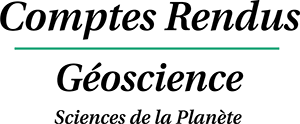

Vous devez vous connecter pour continuer.
S'authentifier